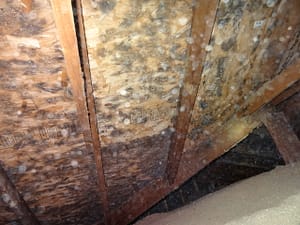Does your attic look like this?
 One of the things that I inspect during a home or commercial property inspection is the attic. If your inspector doesn’t carry a ladder or make every effort to get into the attic, you should tell them to hit the road and get one that does. Occasionally I will come across a home or commercial building that does not have attic access. When that happens, I recommend that an attic access be installed and I use a thermal imaging camera and moisture meter to survey the ceiling in search for signs of problems. Some of the things I may find are moisture intrusion or insulation deficiencies.
One of the things that I inspect during a home or commercial property inspection is the attic. If your inspector doesn’t carry a ladder or make every effort to get into the attic, you should tell them to hit the road and get one that does. Occasionally I will come across a home or commercial building that does not have attic access. When that happens, I recommend that an attic access be installed and I use a thermal imaging camera and moisture meter to survey the ceiling in search for signs of problems. Some of the things I may find are moisture intrusion or insulation deficiencies.
Most people don’t see the attic as a system. Instead they see it as just a space above the ceiling to store stuff or hold insulation. The attic is a system, that if operating properly will help to maximize the life of your shingles and is a major contributor to the overall efficiency of your home. If the attic is not operating properly you may experience a range of problems, e.g. mold growth, wood rot, reduced shingle life, ice dams and increased energy bills.
Aside from having the appropriate amount of insulation present, proper attic ventilation is the key. In Eastern Iowa I predominately see three types of attic ventilation systems:
- Convection system via ridge and soffit vents
- Thermostatically controlled power vent
- Gable vents.
Nearly 100 % of modern homes will utilize a convection system (ridge and soffit vents) to vent the attic. These are very effective and installed during initial construction. If properly installed this system will last the life of the home and be virtually maintenance free.
Thermostatically controlled power vents are usually retrofitted on older homes where heat gain during the summer months is a problem due to poor attic ventilation. These units are effective provided there is ventilation at another point in the attic or soffit to draw air through the attic space. Power vents do not require maintenance, but being mechanical may fail at any time. Failed units typically go unnoticed by the homeowner. Because they are mechanical and may fail at any time, I don’t recommend these unless there is no other option.
Gable vents were installed on homes for many years and are very common. Gable vents are effective and appropriate for the homes they were installed on. Unfortunately the problem lies with contractors and DIY guys. Many roofing contractors will install a ridge vent on the roof even though gable vents exist on the home. This serves to disrupt air currents in the attic and hinders more than it helps. If your home has gable vents then you don’t need a ridge vent.
 Here is a picture of a home where the gable vents were framed in and vinyl siding was installed on the exterior. A ridge vent was installed on the roof but did anyone install soffit vents? The result was mass moisture accumulation in the attic, mold growth on the underside of the roof sheeting and increased heat gain in the summer months to name a few. Vinyl siding manufacturers have many attractive gable vent accessories that can be installed when the siding is done. In this case it would have been better to leave the gable vents in place so the attic could breath.
Here is a picture of a home where the gable vents were framed in and vinyl siding was installed on the exterior. A ridge vent was installed on the roof but did anyone install soffit vents? The result was mass moisture accumulation in the attic, mold growth on the underside of the roof sheeting and increased heat gain in the summer months to name a few. Vinyl siding manufacturers have many attractive gable vent accessories that can be installed when the siding is done. In this case it would have been better to leave the gable vents in place so the attic could breath.
If you are concerned about your attic you can visit our website and order a home or commercial property inspection and we’ll be happy to help.